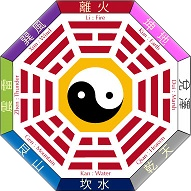
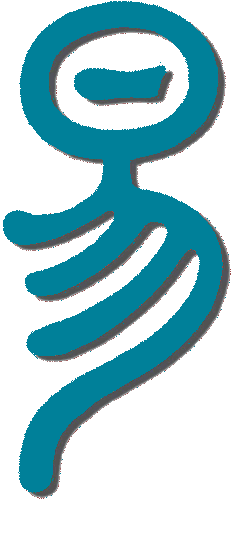
I Ching Explorer

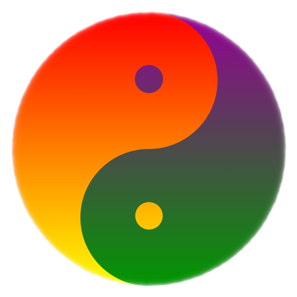
-
☯I Ching Basics
-
☯Consulting I Ching
-
☯Chinese Zodiac
-
☯I Ching Resources
-
If you like our web site and find it useful - donate with PayPal to support new development
Moving Lines
When inquiring about our question to I Ching, the casting method we choose will produce a primary hexagram which potentially can
have from 0 to 6 moving lines. The possibility of getting moving lines is natively "embedded" into most of the casting techniques.
So, the reading of I Ching response to our question should provide a clear way to accommodate and correctly interpret these moving lines.
“Why moving lines are so important?” you may ask. There is an important reason for that.
“A moving line is so called because it is charged with so much energy that it turns into its opposite –
a broken line [changes] into a solid line and a solid line into a broken line, thereby bringing … formation of a new Kua”. [Wu Wei - [9] p. 49.]
In these terms, the moving lines are the quintessential manifestation of change.
But what is the right way to interpret that change? I Ching Scholars significantly vary in their answers to this question.
While many I Ching scholars basically agree on the fact of transitioning to a new hexagram, they visibly disagree on
how this transition to final stage happens.
History of the Problem.
Everything in our world is a subject of changes even I Ching itself. It is a Book of Changes after all.
When it comes to moving lines, the way these moving lines were handled in I Ching was not always the same.
Originally a concept of progressed hexagram didn't exist - diviners were focused on reading of casted primary
hexagram, paying additional attention to the primary hexagram comments, related to its moving lines.
Much later however, many diviners realized, that when lines in primary hexagram are changing, they in fact produce a
chain of related hexagrams evolving to the new, progressed hexagram, which finalizes that transformation.
Detailed analysis and comparison of existing approaches to interpretation of moving lines through-out the history of I Ching,
allowed to identify the following 3 main groups.
- One Line - None-Cumulative Approach.
- All Lines - None-Cumulative Approach.
- All Lines - Consecutive Progression Approach.
☯ One Line - None-Cumulative Approach.
In early I Ching tradition a concept of progressed hexagram was not explicitly present.
It was believed that if your primary hexagram has several moving lines, then only one,
specially defined, most important moving line in primary hexagram should be considered for reading.
For example, according to I Ching expert Roger Green:
“If you have a number of changing lines, you will need to know which of this lines is the most important one,
as this changing line will often hold the key to your situation”. [6] p 97
Taoist Master and renown I Ching expert Alfred Huang is even more explicit on multiple moving lines challenge:
“When there is more than one moving line, particularly when the Yao Texts of the moving lines conflict with each other,
it becomes too complicated to get a clear answer.“ [8], p.p. 16-17
So, according to this approach, if your casting produces a hexagram with multiple moving lines, you have to choose one, most representative line to get your answer.
Special rules were developed in I Ching Tradition to determine which moving line is the most important one and hence,
should be exclusively considered for reading. These rules are briefly summarized below. ([6] p 97)
One Changing Line. Consult that moving line. Note this line’s divine advice and also its position. Take note of the hierarchy of lines, such as line 6 being outside of the situation or representing spiritual guidance and line 5 being in position of power.
Two Changing Lines. If they are of the same type – read only closest to the bottom moving line. If moving lines are of different type – one is Yin and another one is Yang – read only Yin line.
Three Changing Lines. Look only to the central / middle moving line.
Four Changing Lines. Ignore changing lines - Look only at remaining two unchanging lines paying special attention to closest to the top stable line.
Five Changing Lines. Look at the only unchanging line – this only stable line controls the situation in this full of changes situation.
Six Changing Lines. “Consult the description of new progressed hexagram. Do not bother to read any changing lines of the primary hexagram, since before you know it they will have changed to their opposites.” [6], p 97.
So, if for example, your casting has produced a primary hexagram #40 - Relief
and it has three moving lines – 2nd, 4th and 5th as it is shown below:
Primary Hexagram
#40 - Relief
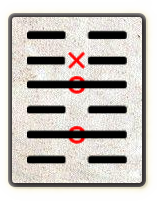
then after applying Three Moving Lines Rule from above, we will come to the following resulting hexagram:
Primary Hexagram
#40
Primary Hexagram
#40

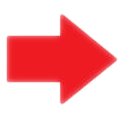

where 4th line - moving Yang - is the key to interpreting a situation you are inquiring about.
To get a full answer now, you will need to read a general comment to hexagram #40 and then
focus yoursef on reading and interpretation of 4th line of the same hexagram.
☯ All Lines - None-Cumulative Approach.
Another valuable approach – see, for example, Karcher [3], p. 44 - recommends using not one but all changing lines
but taken in the line-by-line, bottom-to-the-top, isolated way:
“The steps result from the change of one single line [at a time], with all other [lines] remaining the same. They are not cumulative.” [Karcher], [3] p. 44
For our example of hexagram #40 with three moving lines, this approach will produce a reading with a following sequence of 3-Step none-accumulating changes:

Compared to previously discussed "One Line - None-Cumulative Approach" this, All Lines None-Cummulative Approach
is clearly more inclisive and pays close attention to each moving line.
However it leaves not-answered the same important question:
"In the situation with multiple moving lines, which of the several transformed hexagrams to consider as the main hexagram,
also what should you do if readings in transformed hexagrams contradict each other".
☯ All Lines - Consecutive Progression Approach.
With growing understanding of dynamics of changes, and evolution of interpretation of moving lines in I Ching Community,
a new, advanced concepts were evolved. According to this new, modern understanding, all changes are cumulative
and progression to final target hexagram happens step by step, from the bottom to the top, in all-inclusive way.
And this is what I Ching expert, Master Wu Wei says about it:
“Each of the lines [in hexagram] represents a time earlier or later in the Kua according to the position.
The Bottom Line represents the earliest time and the Top Line the latest time”. The same rules apply to the moving lines.
“The first moving line usually depicts the immediate action to take or avoid, even if it is in Line 2 or higher.
Higher moving lines depict later times in the situation. This is why two lines can contradict each other but still be valid and work together.
It just means that the first moving line refers to now or to sooner after now, and the other line or lines refer to later”. [9] , p 39
“If you obtain more than one moving line, remember that the action starts with the moving line closest to the bottom
and proceeds upward from moving line to moving line. Remember also to disregard nonmoving lines.
The first moving line is closer to present, and later moving lines depict their [respective] times”. [9] p.69
Applying this rule to our example of primary hexagram #40 with three moving lines, we will get the following trajectory of changes:
Primary
#40
Step #1
#16
Step #2
#2
Step #3
#8







So, moving from one changing line to another in a cummulative manner we will get the following time-sequential chain of related hexagrams:
#40 Relief #16 Harmony #2 Receptive #8 Union
What would be the correct interpretation of this dynamics of changes in this example?
Your situation starts from the primary hexagram #40 Removing the Obstacles and
going thru the phases of #16 - Harmony and #2 - Receptive
delivers you to the state of Union - #8 (working together).
In I Ching language first hexagram in this chain of changes is called a primary hexagram, last one - progressed hexagram
and remaining hexagrams in chain of changes from primary to progressed - transitional hexagrams.
To get a full reading of your inquiry to I Ching with this approach, you start with a general comment for primary hexagram moving
then to the next hexagram in the chain, reading its general comment and a comment to its moving line (only) and repeating this
through all transitional hexagram until you reach the final progressed hexagram.
Moving Hexagram Transformations
In Gua Transformations page of this web portal we have discussed important
hexagram transformations widely used in reading and interpretation of traditional hexagrams (without moving lines).
They include, among others, nuclear-, inversed (opposite) -, reversed-, rotated- and evolutional hexagram tranformations.
In this section we will discuss new group of hexagram transformations introduced in the last 15-20 years which
can be applied only to hexagrams with moving lines. We will be talking specifically about 3 new tranformations here:
- Yin-Tranformed Hexagrams
- Yang-Tranformed Hexagrams
- Anti-Hexagrams
☯ Yin- and Yang- Change Transformations.
The concept of Yin- and Yang- Change Operators belongs to Stephen Karcher, who proposed and described these transformations
in his innovative work [3].
This is what Yin- and Yang- Change Operators are in his own words:
“The Change Operators are a very powerful modern technique for determining the transformative action of the Two Powers
in a given situation. This can give a real sense of inner and outer strategies and a much clearer understanding
of the movement of Change as a whole.” [3], p. 45
Yang Operator
“The Yang or Energy Operator describes the actions thru which
Change occurs. It offers inner stance or strategy towards the outer world.” [3], p. 45.
To get Yang transformation replace every changing line in your hexagram with Yang-line and every stable, not-changing line - with Yin line.
Applying Yang-Change-Operator to our example of hexagram #40 with 3 moving lines we get the following diagram:
Primary
#40
Yang-Transformed
#47



Yin Operator
“The Yin, Inner or Context Operator describes the
place where Change occurs. It offers inner stance or strategy towards the inner world.” [3], p. 45.
To get a Yin transformation replace every changing line in your hexagram with Yin-line and every stable, not-changing line - with Yang line.
For the same example of hexagram #40 with 3 moving lines, Yin-Change-Operator will produce the following diagram:
Primary
#40
Yin-Transformed
#22



As we can see from their definitions, Change Operators depend only on changing (moving) lines in the hexagram and not on the hexagram itself.
“Thus any figure with changing lines, in, say second, fourth and fifth places will have the same [Yin-, Yang-] operators”. [3], p. 45.
Anti-Hexagrams
Another member of opposite group of hexagrams (which originally includes inversed and
reversed hexagrams) is a so-called Anti-Hexagram.
The name of this hexagram type was coined by Russel Cottrell in his online article
and was originally proposed and discussed in more details by Jane Schorre and Carrin Dunne in their book Yijing Wondering and Wandering [12].
In contrast to inversed and reversed opposite hexagrams, which always exist – even if there is no moving lines - anti-hexagram exist only if at least one line in primary hexagram is moving.
To get the anti-hexagram for any changing primary hexagram, you simply invert all non-changing lines to their opposite polarity (Yin-to-Yan and vice versa) leaving moving lines intact.
Primary
#40
Anti-Hexagram
#14



What is so special about Anti-Hexagrams and why they are so important for advanced reading in I Ching?
To understand better the answer to this question let's place anti-hexagram and progressed hexagram side-by-side.
Anti-
Hexagram
Hexagram
#14 -
Abundance
Abundance
Primary
Hexagram
Hexagram
#40 -
Relief
Relief
Progressed
Hexagram
Hexagram
#8 -
Union
Union
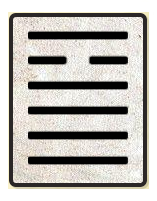

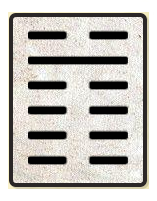
As one can see from this example, anti-hexagram is in essence an inversion (mirror) of progressed hexagram!
Being the inverse-opposite of progressed hexagram it shows where progression of change in your situation is NOT going to.
In our example – it is not the situation of Abundance that you could expect from this change.
Summary of Moving Transformations.
Discussed in this section new group of hexagram transformations provide a powerfull tool for divination readings
when the situations in original hexagram is fluid and is a subject of change itself.
While Yin- and Yang- Change Operators provide insights on place (Yin) and
actions (Yang) where change occurs, offering us the inner strategy towards the
inner (Yin) and outer (Yang) worlds, Anti-Hexagram
explains where your changing situation is not heading.
Bringing together Yin-, Yang- and Anti-Hexagram transformations in one unified diagram,
we will get the following change-related advanced reading layout.
